 |
libTheSky
Routines to compute sky positions of Sun, Moon, planets and more
|
 |
libTheSky
Routines to compute sky positions of Sun, Moon, planets and more
|
Procedures to determine the visibility of objects. More...
Functions/Subroutines | |
| subroutine | best_planet_xsmag (jdin, plid, jdout, xsmag, rscwarn) |
| Find the moment (JD) of optimal excess magnitude for a planet, i.e. the lowest mag - lim.mag. | |
| real(double) function | best_planet_visibility (jd, pl) |
| Find a rough indication for the best moment (JD) to observe a planet on a given day (jd). Start out by demanding that Sun alt < -6deg, but relax this if problematic. This often results in the moment where Sun alt is indeed -6deg. | |
| subroutine | planet_visibility_tonight (jd, pl, sunalt, plalt, comp, plvis, plazs, rts, tts, sts, ras, tas, sas, rscwarn) |
| Compute when a given planet is visible in a given night. | |
| logical function | comet_invisible (jd, cometid, mlim, minalt) |
| Cheap function to determine whether a comet is invisible at a given time, based on a magnitude and altitude limit. | |
| real(double) function | transitalt (lat, dec) |
| Compute the transit altitude of an object with given declination for an observer with a given geographic latitude. | |
| subroutine | best_obs_date_ra (year, ra, accuracy, mon, dy) |
| Compute the best date in the year to observe an object with a given right ascension. | |
| real(double) function | get_dra_obj (jd) |
| Compute the difference between a given right ascension and the RA of the Sun, used privately by best_obs_date_ra() | |
| real(double) function | airmass (alt) |
| Compute the airmass for a celestial object with a given TRUE altitude. | |
| real(double) function | airmass_la (alt) |
| Compute the airmass for a celestial object with a given apparent altitude; low-accuracy alternative for airmass() | |
| real(double) function | extinction_magpam (ele) |
| Compute the extinction in magnitdes per unit airmass for an observer with given elevation. | |
| real(double) function | extinction_mag (alt, ele) |
| Compute the extinction in magnitdes for an observer with given elevation and an object with given TRUE altitude. | |
| real(double) function | extinction_fac (alt, ele) |
| Compute the extinction factor for an observer with given elevation and an object with given altitude. | |
| real(double) function | limmag_full (year, month, obselev, obslat, sunalt, sunelon, moonphase, moonalt, moonelon, objalt, humid, airtemp, snrat, verbosity) |
| Calculate limiting magnitude based on Sun and Moon positions and phase, and on the altitude of the observed object. | |
| subroutine | limmag_extinction (month, obslat, obselev, objalt, relhum, temp, band1, band2, extcoef, extmag) |
| Calculate limiting magnitude based on Sun altitude and Moon phase. | |
| subroutine | limmag_skybrightness (year, sunalt, sunelon, moonphase, moonalt, moonelon, objalt, band1, band2, extcoef, skybr) |
| Calculate sky brightness based on Sun altitude and Moon phase. | |
| real(double) function | limmag_jd (jd, objra, objdec, objalt, lat, height) |
| Calculate limiting magnitude based on JD and object altitude, wrapper for limmag_full() | |
| real(double) function | limmag_zenith_jd (jd, lat, lon, height) |
| Calculate limiting magnitude for the local zenith, based on JD and observer's location. | |
| real(double) function | limmag_jd_pl (jd, pl) |
| Calculate limiting magnitude based on JD and planet ID, wrapper for limmag_jd() | |
| real(double) function | limmag_sun_airmass (month, sunalt, sunaz, objalt, objaz, lat, height) |
| Calculate limiting magnitude based on Sun altitude and object altitude (airmass). Assumes New Moon. | |
| real(double) function | limmag_sun (sunalt) |
| Calculate limiting magnitude, based on the altitude of the Sun. Simplified version of limmag_full() | |
| real(double) function | pl_xsmag (jd, pl) |
| Compute the excess magnitude for planet pl at JD, considering Sun, Moon and airmass. | |
| real(double) function | pl_xsmag_pl (jd) |
| Compute the excess magnitude at JD, wrapper for pl_xsmag() for solvers. The planet ID pl0 is passed through module planetdata. | |
| real(double) function | pl_xsmag_la (jd, pl) |
| Compute the excess magnitude for planet pl at JD, considering airmass and Sun alt - low-accuracy version of pl_xsmag() | |
| real(double) function | pl_xsmag_la_pl (jd) |
| Compute the excess magnitude at JD, wrapper for pl_xsmag_la() for solvers. The planet ID pl0 is passed through module planetdata. | |
| real(double) function | aperture (xsmag, pupil, tc) |
| Aperture diameter in centimetres needed to observe an object with given excess magnitude (0: no instrument needed) | |
| elemental real(double) function | skybrightness_mas2_from_mlim (mlim) |
| Convert naked-eye visual limiting magnitude (V) to sky surface brightness in (B) magnitudes per square arcsecond. | |
| elemental real(double) function | skybrightness_mlim_from_mas2 (skybright) |
| Convert sky surface brightness in (B) magnitudes per square arcsecond to naked-eye visual limiting magnitude (V) | |
| elemental real(double) function | skybrightness_mlim_from_cdm2 (cdm2) |
| Convert sky brightness in candela per square meter to naked-eye visual limiting magnitude (V) | |
| elemental real(double) function | skybrightness_cdm2_from_mlim (mlim) |
| Convert limiting visual magnitude to sky brightness in candela per square meter. | |
| elemental real(double) function | skybrightness_cdm2_from_nl (nl) |
| Convert sky brightness in nanolambert to candela per square meter. | |
| elemental real(double) function | skybrightness_nl_from_cdm2 (cdm2) |
| Convert sky brightness in candela per square meter to nanolambert. | |
Procedures to determine the visibility of objects.
| real(double) function thesky_visibility::airmass | ( | real(double), intent(in) | alt | ) |
Compute the airmass for a celestial object with a given TRUE altitude.
| alt | TRUE altitude of object (radians) |
| airmass | The airmass (-) |
Definition at line 539 of file visibility.f90.
References airmass().
Referenced by airmass(), extinction_mag(), thesky_daylight::extinction_sun(), and pl_xsmag_la().

| real(double) function thesky_visibility::airmass_la | ( | real(double), intent(in) | alt | ) |
Compute the airmass for a celestial object with a given apparent altitude; low-accuracy alternative for airmass()
| alt | Apparent altitude of object (radians) |
| airmass_la | The airmass (-) |
Definition at line 573 of file visibility.f90.
References airmass_la().
Referenced by airmass_la().

| real(double) function thesky_visibility::aperture | ( | real(double), intent(in) | xsmag, |
| real(double), intent(in), optional | pupil, | ||
| real(double), intent(in), optional | tc ) |
Aperture diameter in centimetres needed to observe an object with given excess magnitude (0: no instrument needed)
| xsmag | Excess magnitude: magnitude of an object MINUS limiting magnitude (>0: too weak for naked eye) |
| pupil | Pupil diameter (mm, default: 6) |
| tc | Transmission coefficient of the instrument (default: 0.8 = 80%) |
| aperture | The aperture diameter (cm) |
Definition at line 1341 of file visibility.f90.
References aperture().
Referenced by aperture().

| subroutine thesky_visibility::best_obs_date_ra | ( | integer, intent(in) | year, |
| real(double), intent(in) | ra, | ||
| integer, intent(in) | accuracy, | ||
| integer, intent(out) | mon, | ||
| integer, intent(out) | dy ) |
Compute the best date in the year to observe an object with a given right ascension.
| year | Year (CE) |
| RA | Right ascension of the object |
| accuracy | Get an accurate (but more expensive) result: 0-no, 1-yes |
| mon | Month of year (output) |
| dy | Day of month (output) |
Definition at line 462 of file visibility.f90.
References get_dra_obj().

| real(double) function thesky_visibility::best_planet_visibility | ( | real(double), intent(in) | jd, |
| integer, intent(in) | pl ) |
Find a rough indication for the best moment (JD) to observe a planet on a given day (jd). Start out by demanding that Sun alt < -6deg, but relax this if problematic. This often results in the moment where Sun alt is indeed -6deg.
| jd | Julian day to compute best moment for |
| pl | Planet to compute visibility for (0-Moon, 1-Mercury, etc.) |
| best_planet_visibility | Best moment to observe the planet (JD) |
Definition at line 125 of file visibility.f90.
References best_planet_visibility(), thesky_planetdata::nplanpos, thesky_planets::planet_position(), thesky_planetdata::planpos, thesky_riset::riset(), and thesky_local::tz.
Referenced by best_planet_visibility().
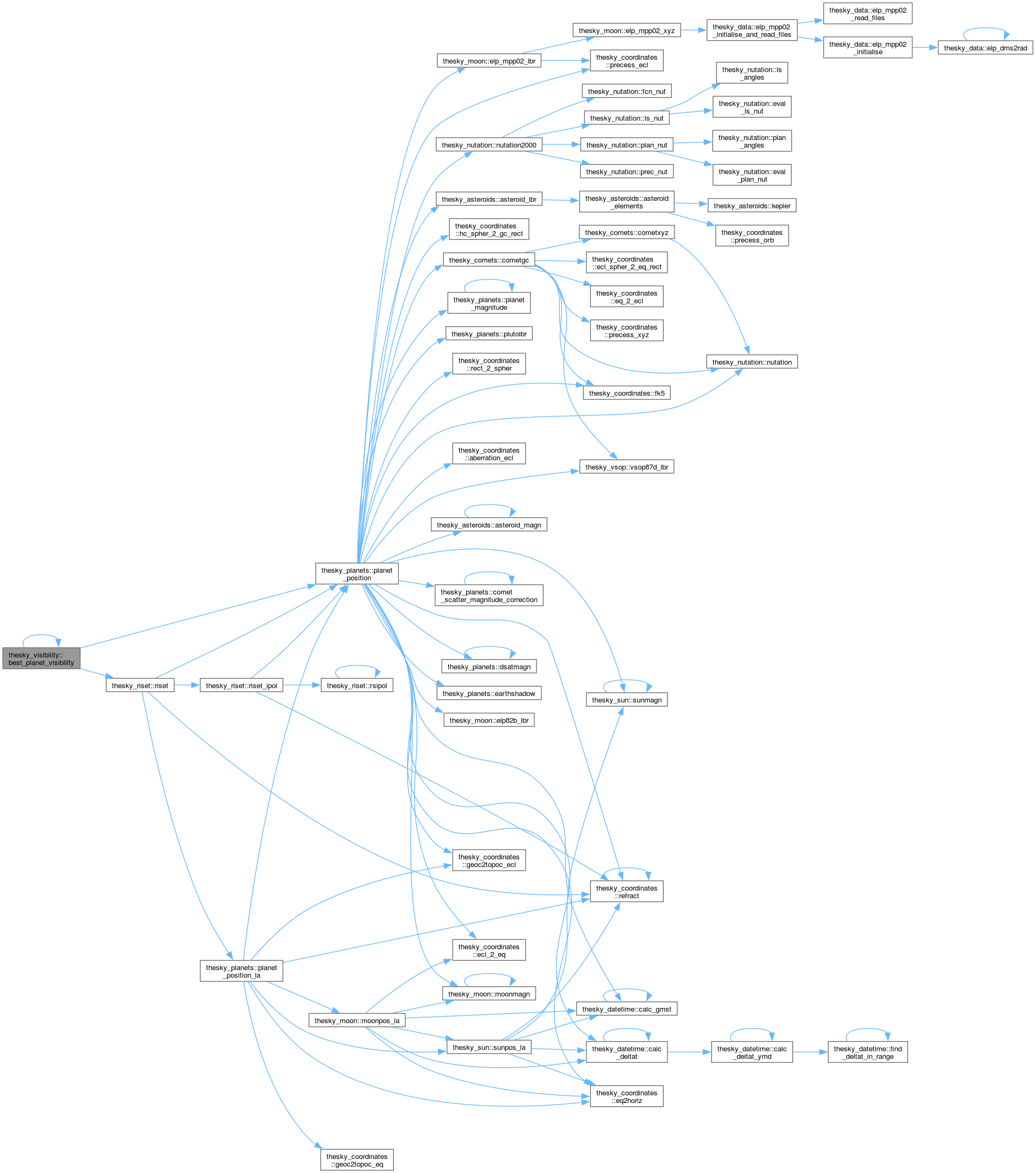
| subroutine thesky_visibility::best_planet_xsmag | ( | real(double), intent(in) | jdin, |
| integer, intent(in) | plid, | ||
| real(double), intent(out) | jdout, | ||
| real(double), intent(out), optional | xsmag, | ||
| logical, intent(in), optional | rscwarn ) |
Find the moment (JD) of optimal excess magnitude for a planet, i.e. the lowest mag - lim.mag.
| jdin | Initial guess for the moment of best excess magnitude (input) |
| plID | Planet to compute visibility for (0-Moon, 1-Mercury, etc.) |
| jdout | Moment of best excess magnitude (output) |
| xsmag | Excess magnitude at that moment (magnitude - limiting magnitude; <0: ~visible to the naked eye) (output, optional) |
| rsCWarn | Print convergence warnings in riset() (input, optional; default = true) |
Definition at line 76 of file visibility.f90.
References thesky_datetime::gettz(), thesky_planetdata::pl0, pl_xsmag_pl(), and planet_visibility_tonight().

| logical function thesky_visibility::comet_invisible | ( | real(double), intent(in) | jd, |
| integer, intent(in) | cometid, | ||
| real(double), intent(in) | mlim, | ||
| real(double), intent(in) | minalt ) |
Cheap function to determine whether a comet is invisible at a given time, based on a magnitude and altitude limit.
| jd | Julian day for calculation |
| cometID | Comet ID |
| mlim | Maximum magnitude, below which the comet is defined as visible (deg) |
| minalt | Minimum transit altitude, above which the comet is defined as visible (deg) |
| comet_invisible | Comet is invisible (true/false) |
Definition at line 391 of file visibility.f90.
References comet_invisible(), thesky_cometdata::cometdiedatp, thesky_cometdata::cometelems, thesky_comets::cometgc(), thesky_coordinates::ecl_2_eq(), thesky_local::lat0, thesky_planetdata::planpos, and transitalt().
Referenced by comet_invisible().

| real(double) function thesky_visibility::extinction_fac | ( | real(double), intent(in) | alt, |
| real(double), intent(in), optional | ele ) |
Compute the extinction factor for an observer with given elevation and an object with given altitude.
| alt | Altitude of object (radians) |
| ele | Evelation of the observer above sea level (metres; optional) |
| extinction_fac | Extinction factor (-) |
Definition at line 671 of file visibility.f90.
References extinction_fac(), and extinction_mag().
Referenced by extinction_fac().

| real(double) function thesky_visibility::extinction_mag | ( | real(double), intent(in) | alt, |
| real(double), intent(in), optional | ele ) |
Compute the extinction in magnitdes for an observer with given elevation and an object with given TRUE altitude.
| alt | Altitude of object (radians) |
| ele | Evelation of the observer above sea level (metres; optional) |
| extinction_mag | Extinction (magnitudes) |
Definition at line 640 of file visibility.f90.
References airmass(), extinction_mag(), and extinction_magpam().
Referenced by extinction_fac(), and extinction_mag().

| real(double) function thesky_visibility::extinction_magpam | ( | real(double), intent(in) | ele | ) |
Compute the extinction in magnitdes per unit airmass for an observer with given elevation.
| ele | Evelation of the observer above sea level (metres) |
| extinction_magPam | Extinction (magnitdes per unit airmass) |
Definition at line 610 of file visibility.f90.
References extinction_magpam().
Referenced by extinction_mag(), extinction_magpam(), and pl_xsmag_la().

| real(double) function thesky_visibility::get_dra_obj | ( | real(double), intent(in) | jd | ) |
Compute the difference between a given right ascension and the RA of the Sun, used privately by best_obs_date_ra()
| jd | Julian day |
| get_dRA_obj | Difference between a given right ascension and the RA of the Sun (rad) |
Definition at line 507 of file visibility.f90.
References get_dra_obj(), thesky_planets::planet_position(), and thesky_planetdata::planpos.
Referenced by best_obs_date_ra(), and get_dra_obj().
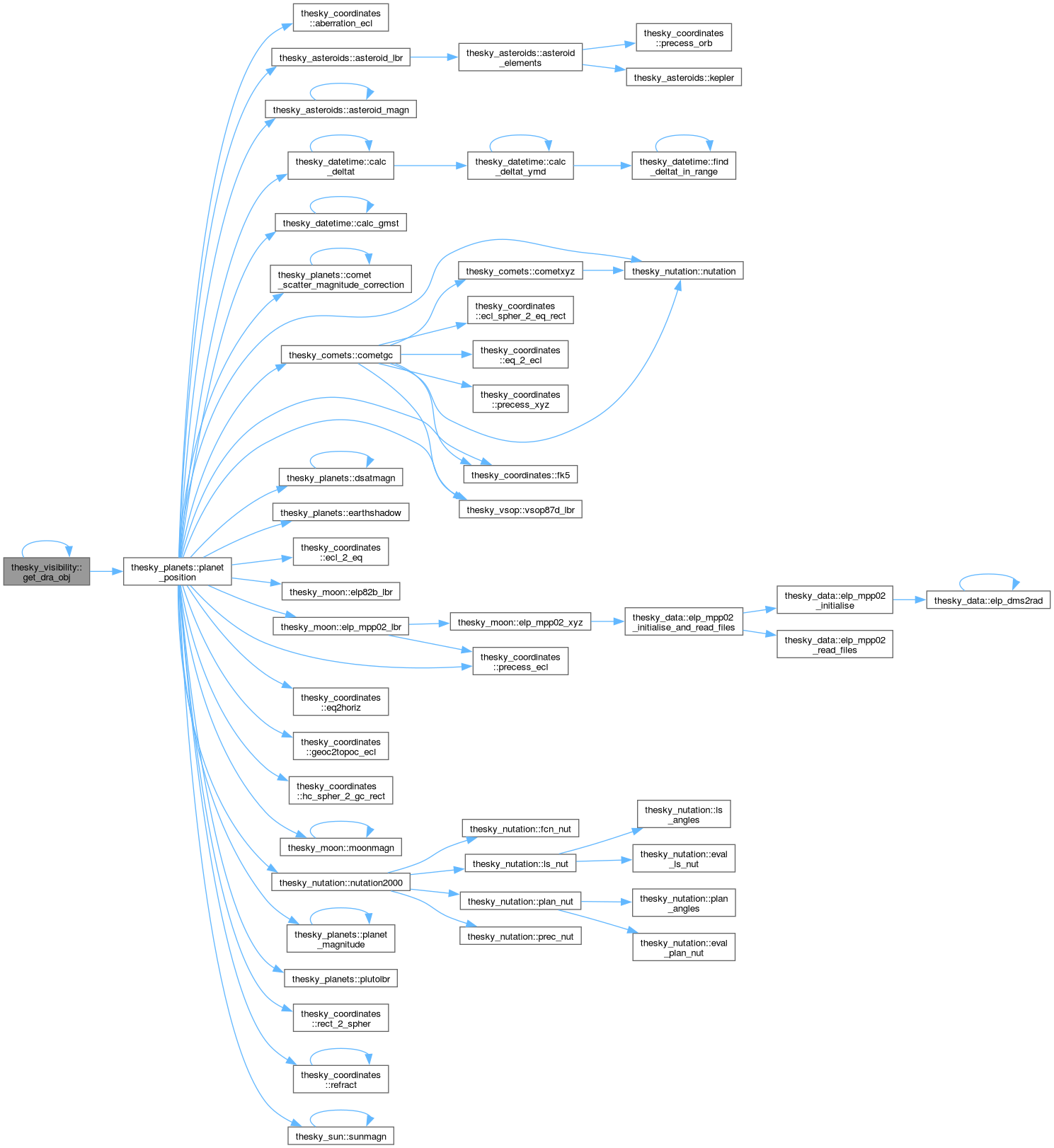
| subroutine thesky_visibility::limmag_extinction | ( | integer, intent(in) | month, |
| real(double), intent(in) | obslat, | ||
| real(double), intent(in) | obselev, | ||
| real(double), intent(in) | objalt, | ||
| real(double), intent(in) | relhum, | ||
| real(double), intent(in) | temp, | ||
| integer, intent(in) | band1, | ||
| integer, intent(in) | band2, | ||
| real(double), dimension(5), intent(out) | extcoef, | ||
| real(double), dimension(5), intent(out) | extmag ) |
Calculate limiting magnitude based on Sun altitude and Moon phase.
| month | Month of observation (for approximate Sun RA) |
| obsLat | Latitude of the observed (rad) |
| obsElev | Elevation of the observer (m) |
| objAlt | Altitude of the observed object (rad) |
| relHum | Relative humidity |
| temp | Air temperature |
| band1 | First of UBVRI bands to compute (1-5); compute band1-band2 |
| band2 | Last of UBVRI bands to compute (1-5); compute band1-band2 |
| extCoef | Atmospheric extinction for UBVRI (output) |
| extMag | Delta magnitude due to atmospheric extinction for UBVRI (output) |
Definition at line 802 of file visibility.f90.
Referenced by limmag_full().
| real(double) function thesky_visibility::limmag_full | ( | integer, intent(in) | year, |
| integer, intent(in) | month, | ||
| real(double), intent(in) | obselev, | ||
| real(double), intent(in) | obslat, | ||
| real(double), intent(in) | sunalt, | ||
| real(double), intent(in) | sunelon, | ||
| real(double), intent(in) | moonphase, | ||
| real(double), intent(in) | moonalt, | ||
| real(double), intent(in) | moonelon, | ||
| real(double), intent(in) | objalt, | ||
| real(double), intent(in), optional | humid, | ||
| real(double), intent(in), optional | airtemp, | ||
| real(double), intent(in), optional | snrat, | ||
| integer, intent(in), optional | verbosity ) |
Calculate limiting magnitude based on Sun and Moon positions and phase, and on the altitude of the observed object.
| year | Year of observation (for solar cycle) |
| month | Month of observation (for approximate Sun RA) |
| obsElev | Elevation of the observer (m) |
| obsLat | Latitude of the observer (rad) |
| sunAlt | Altitude of the Sun (rad) |
| sunElon | Elongation object-Sun (rad) |
| moonPhase | Phase of the Moon (fraction) |
| moonAlt | Altitude of the Moon (rad) |
| moonElon | Elongation object-Moon (rad) |
| objAlt | Altitude of the observed object (rad) |
| humid | Relative humidity (%; optional, default: 70) |
| airTemp | Air temperature (degrees Celsius; optional, default: 10) |
| snrat | Snellen ratio for vision (optional, default: 1) |
| verbosity | Verbosity (optional, default: 0=quiet) |
| limmag_full | Limiting magnitude - return >= 99 if the object is below the horizon |
Definition at line 717 of file visibility.f90.
References limmag_extinction(), limmag_full(), and limmag_skybrightness().
Referenced by limmag_full(), limmag_jd(), and limmag_sun_airmass().

| real(double) function thesky_visibility::limmag_jd | ( | real(double), intent(in), value | jd, |
| real(double), intent(in), value | objra, | ||
| real(double), intent(in), value | objdec, | ||
| real(double), intent(in), value | objalt, | ||
| real(double), intent(in), optional | lat, | ||
| real(double), intent(in), optional | height ) |
Calculate limiting magnitude based on JD and object altitude, wrapper for limmag_full()
| jd | Julian day |
| objRA | Right ascension of the observed object (rad) |
| objDec | Declination of the observed object (rad) |
| objAlt | Altitude of the observed object (rad) |
| lat | Latitude of the observer (optional; rad) |
| height | Height/altitude of the observer above sea level (optional; metres) |
| limmag_jd | Limiting magnitude |
Definition at line 985 of file visibility.f90.
References thesky_local::day, thesky_local::height, thesky_local::lat0, limmag_full(), limmag_jd(), thesky_local::month, thesky_planetdata::nplanpos, thesky_planets::planet_position_la(), thesky_planetdata::planpos, and thesky_local::year.
Referenced by limmag_jd(), limmag_jd_pl(), limmag_zenith_jd(), and pl_xsmag().
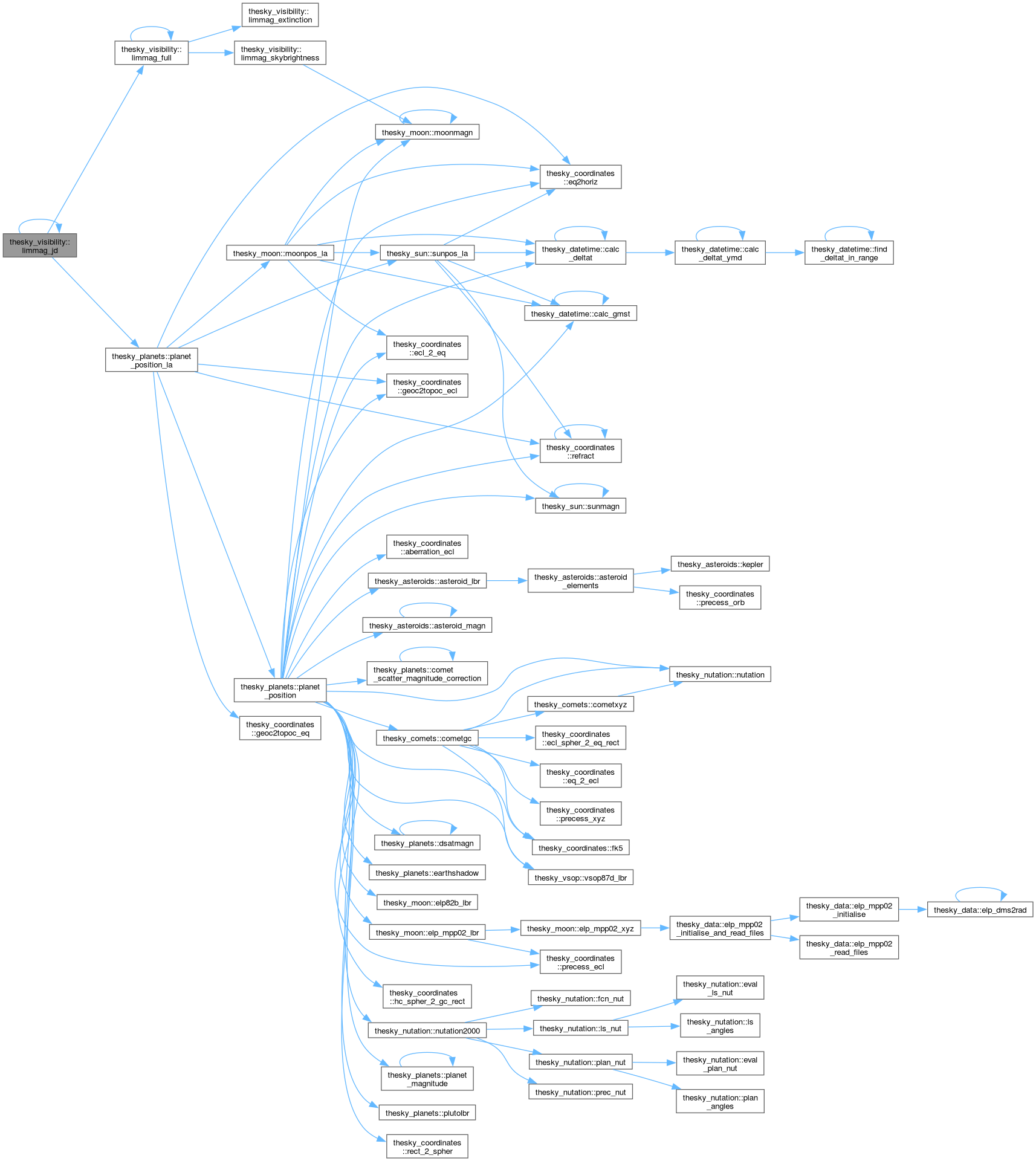
| real(double) function thesky_visibility::limmag_jd_pl | ( | real(double), intent(in) | jd, |
| integer, intent(in) | pl ) |
Calculate limiting magnitude based on JD and planet ID, wrapper for limmag_jd()
| jd | Julian day |
| pl | Planet ID |
| limmag_jd_pl | Limiting magnitude |
Definition at line 1073 of file visibility.f90.
References limmag_jd(), limmag_jd_pl(), thesky_planetdata::nplanpos, thesky_planets::planet_position_la(), and thesky_planetdata::planpos.
Referenced by limmag_jd_pl().
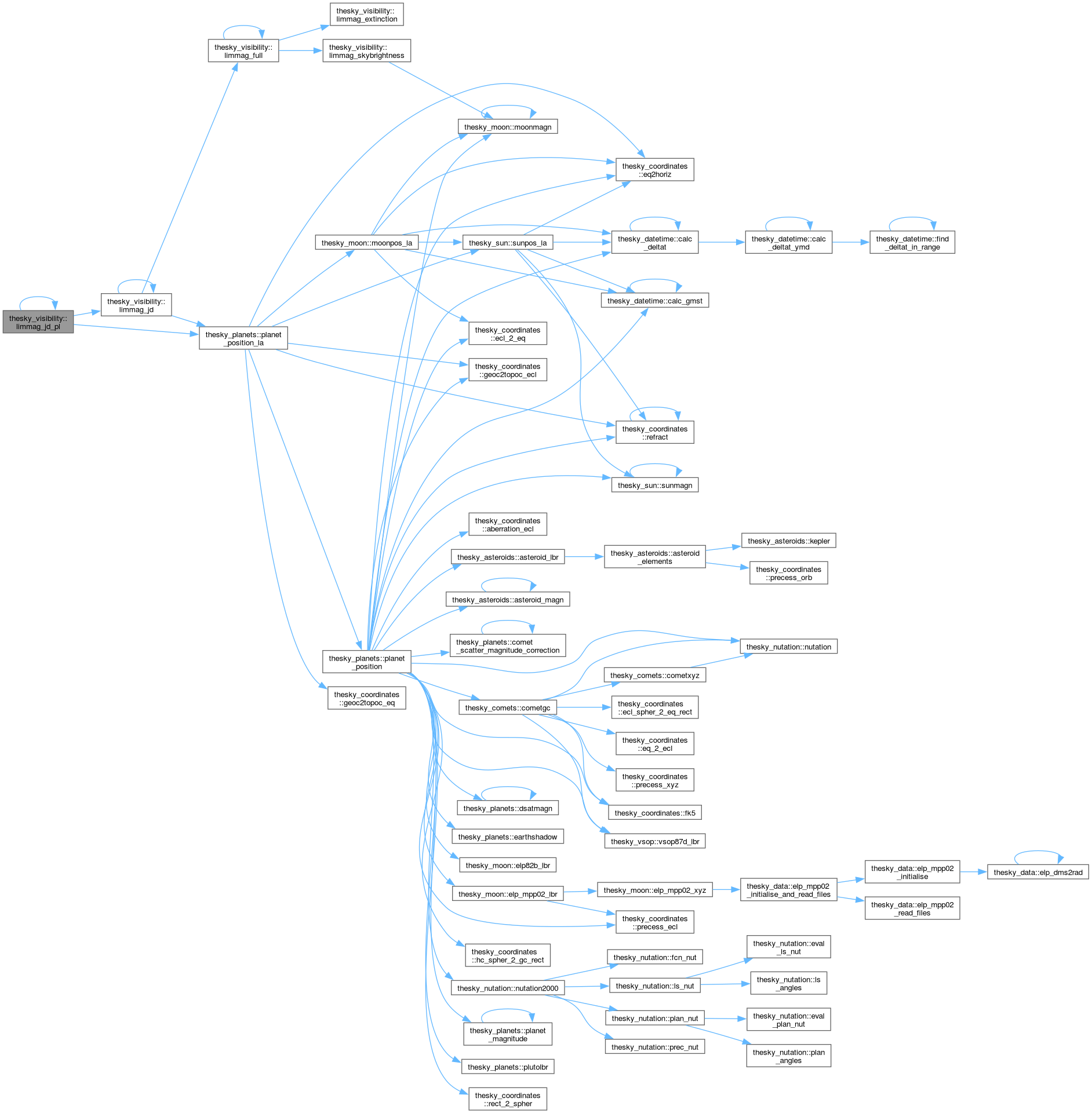
| subroutine thesky_visibility::limmag_skybrightness | ( | integer, intent(in) | year, |
| real(double), intent(in), value | sunalt, | ||
| real(double), intent(in), value | sunelon, | ||
| real(double), intent(in), value | moonphase, | ||
| real(double), intent(in), value | moonalt, | ||
| real(double), intent(in), value | moonelon, | ||
| real(double), intent(in), value | objalt, | ||
| integer, intent(in) | band1, | ||
| integer, intent(in) | band2, | ||
| real(double), dimension(5), intent(in) | extcoef, | ||
| real(double), dimension(5), intent(out) | skybr ) |
Calculate sky brightness based on Sun altitude and Moon phase.
| year | Year CE (for the solar cycle) |
| objAlt | Altitude of the observed object (rad) |
| moonAlt | Moon altitude (rad) |
| sunAlt | Sun altitude (rad) |
| moonPhase | Moon illuminated fraction (0-1) |
| moonElon | Moon elongation from observed object (rad) |
| sunElon | Sun elongation from observed object (rad) |
| band1 | First of UBVRI bands to compute (1-5); compute band1-band2 |
| band2 | Last of UBVRI bands to compute (1-5); compute band1-band2 |
| extCoef | Extinction for UBVRI |
| skyBr | Sky brightness for UBVRI in nanoLambert (output) |
Definition at line 873 of file visibility.f90.
References thesky_moon::moonmagn().
Referenced by limmag_full().

| real(double) function thesky_visibility::limmag_sun | ( | real(double), intent(in) | sunalt | ) |
Calculate limiting magnitude, based on the altitude of the Sun. Simplified version of limmag_full()
| sunAlt | Altitude of the Sun (rad) |
| limmag_sun | Limiting magnitude |
Definition at line 1167 of file visibility.f90.
References limmag_sun().
Referenced by limmag_sun(), and pl_xsmag_la().

| real(double) function thesky_visibility::limmag_sun_airmass | ( | integer, intent(in) | month, |
| real(double), intent(in), value | sunalt, | ||
| real(double), intent(in), value | sunaz, | ||
| real(double), intent(in), value | objalt, | ||
| real(double), intent(in), value | objaz, | ||
| real(double), intent(in), optional | lat, | ||
| real(double), intent(in), optional | height ) |
Calculate limiting magnitude based on Sun altitude and object altitude (airmass). Assumes New Moon.
| month | Month of the year |
| sunAlt | Altitude of the Sun (rad) |
| sunAz | Azimuth of the Sun (rad) |
| objAlt | Altitude of the observed object (rad) |
| objAz | Azimuth of the observed object (rad) |
| lat | Latitude of the observer (optional; rad) |
| height | Height/altitude of the observer above sea level (optional; metres) |
| limmag_sun_airmass | Limiting magnitude |
Definition at line 1115 of file visibility.f90.
References thesky_local::height, thesky_local::lat0, limmag_full(), limmag_sun_airmass(), thesky_local::month, and thesky_local::year.
Referenced by limmag_sun_airmass().

| real(double) function thesky_visibility::limmag_zenith_jd | ( | real(double), intent(in) | jd, |
| real(double), intent(in) | lat, | ||
| real(double), intent(in) | lon, | ||
| real(double), intent(in) | height ) |
Calculate limiting magnitude for the local zenith, based on JD and observer's location.
| jd | Julian day |
| lat | Latitude of the observer (rad) |
| lon | Longitude of the observer (rad) |
| height | Height/altitude of the observer above sea level (metres) |
| limmag_zenith_jd | Limiting magnitude |
Definition at line 1040 of file visibility.f90.
References thesky_datetime::calc_gmst(), thesky_coordinates::horiz2eq(), limmag_jd(), and limmag_zenith_jd().
Referenced by limmag_zenith_jd().
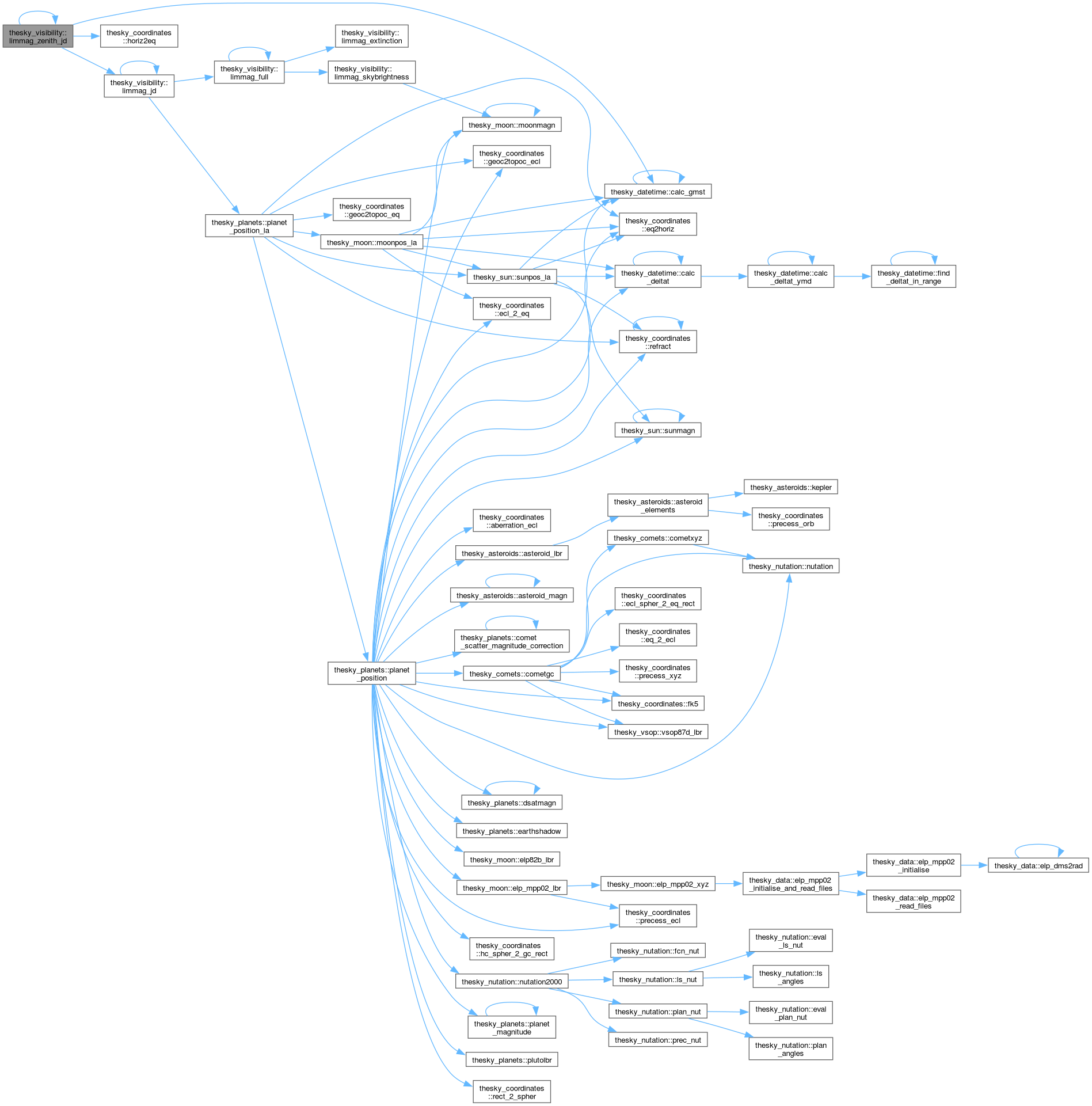
| real(double) function thesky_visibility::pl_xsmag | ( | real(double), intent(in) | jd, |
| integer, intent(in) | pl ) |
Compute the excess magnitude for planet pl at JD, considering Sun, Moon and airmass.
| jd | Julian day for moment of interest |
| pl | Planet ID (0-Moon, 1-Mer, 8-Nep, >10-comet |
| pl_xsmag | The excess magnitude |
Definition at line 1215 of file visibility.f90.
References limmag_jd(), pl_xsmag(), thesky_planets::planet_position_la(), and thesky_planetdata::planpos.
Referenced by pl_xsmag(), and pl_xsmag_pl().
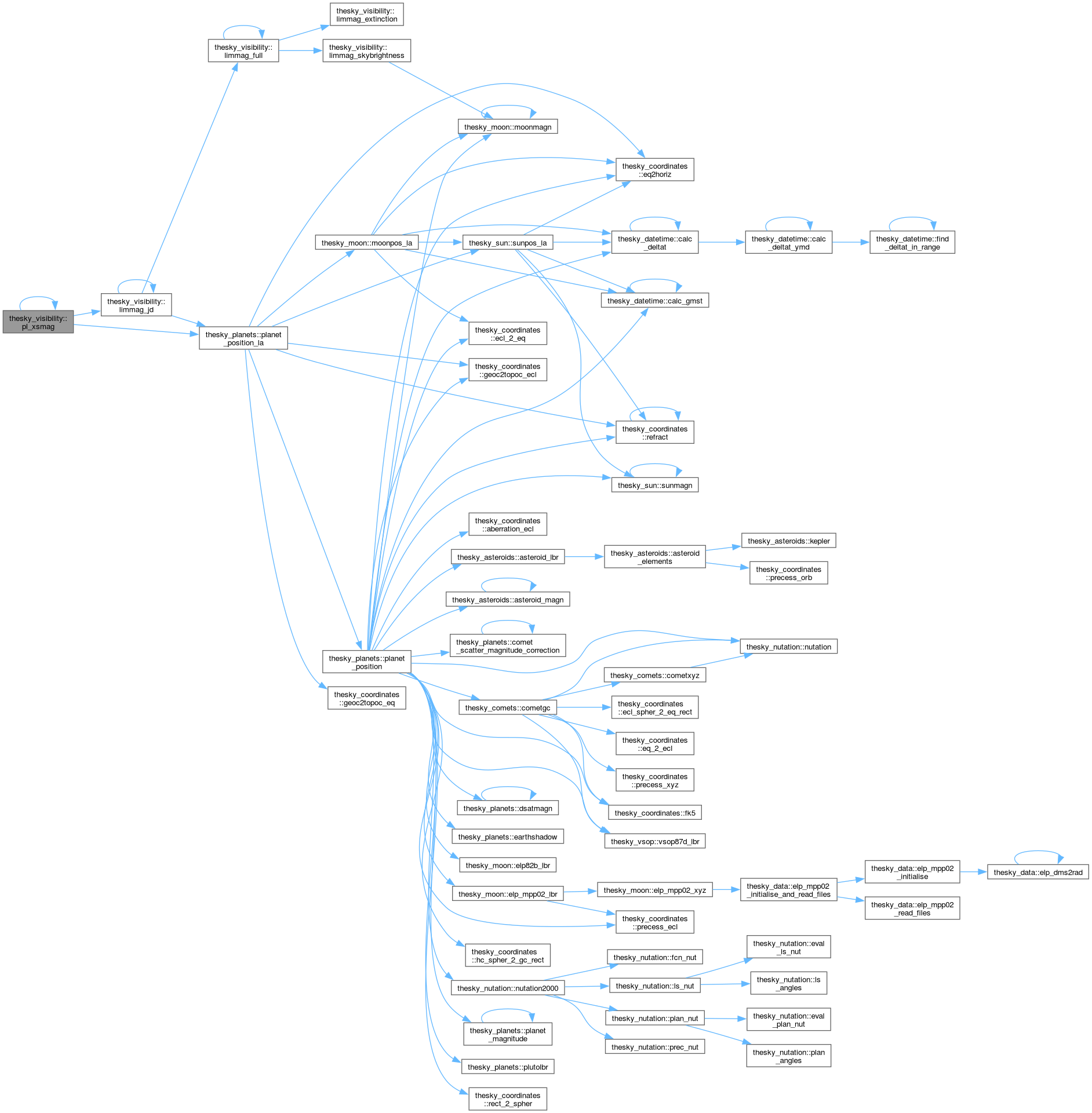
| real(double) function thesky_visibility::pl_xsmag_la | ( | real(double), intent(in) | jd, |
| integer, intent(in) | pl ) |
Compute the excess magnitude for planet pl at JD, considering airmass and Sun alt - low-accuracy version of pl_xsmag()
| jd | Julian day for moment of interest |
| pl | Planet ID (0-Moon, 1-Mer, 8-Nep, >10-comet |
| pl_xsmag_la | The excess magnitude |
Definition at line 1276 of file visibility.f90.
References airmass(), extinction_magpam(), limmag_sun(), pl_xsmag_la(), thesky_planets::planet_position_la(), and thesky_planetdata::planpos.
Referenced by pl_xsmag_la(), and pl_xsmag_la_pl().
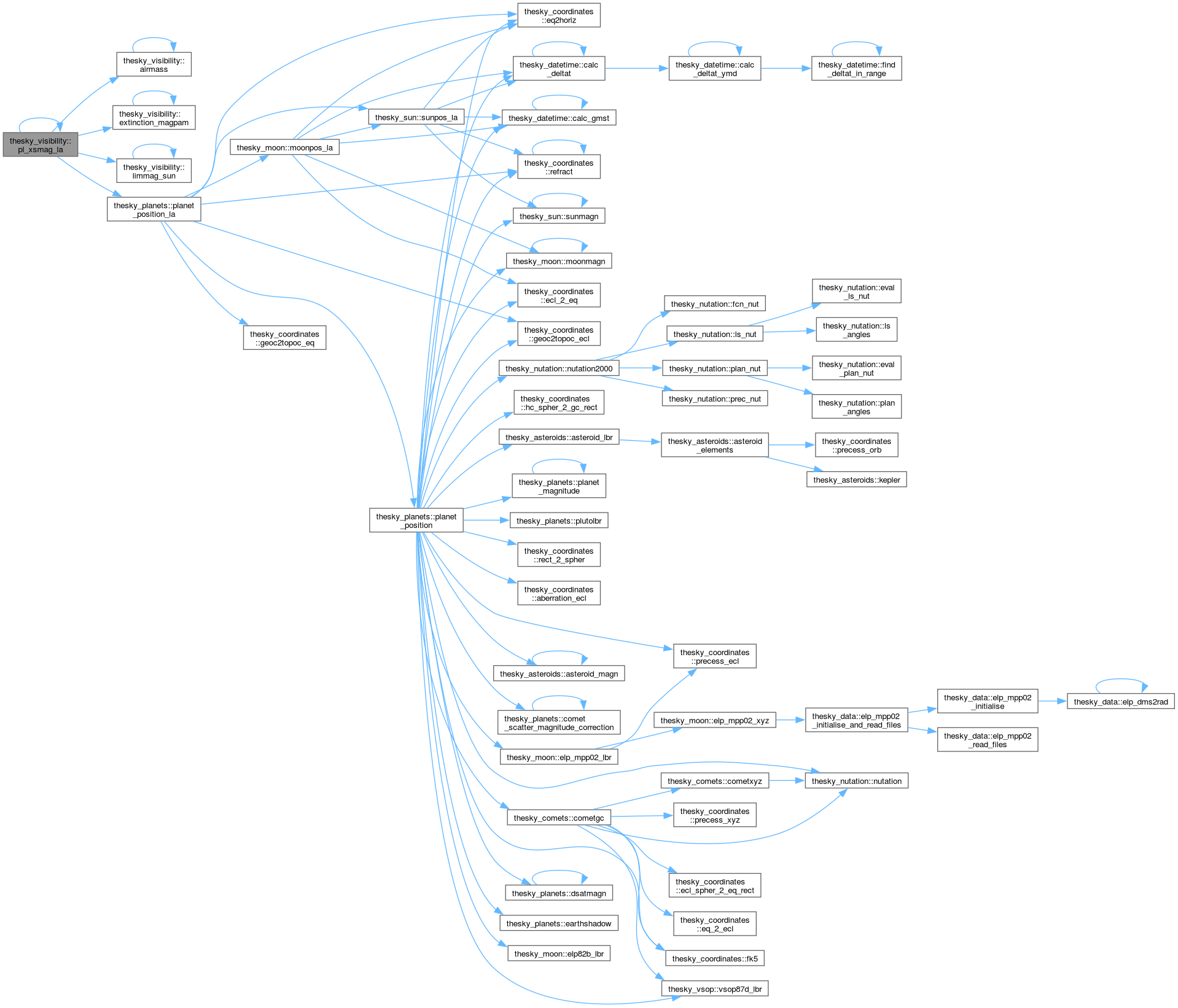
| real(double) function thesky_visibility::pl_xsmag_la_pl | ( | real(double), intent(in) | jd | ) |
Compute the excess magnitude at JD, wrapper for pl_xsmag_la() for solvers. The planet ID pl0 is passed through module planetdata.
| jd | Julian day for moment of interest |
| pl_xsmag_la_pl | The excess magnitude |
Definition at line 1309 of file visibility.f90.
References thesky_planetdata::pl0, pl_xsmag_la(), and pl_xsmag_la_pl().
Referenced by pl_xsmag_la_pl().
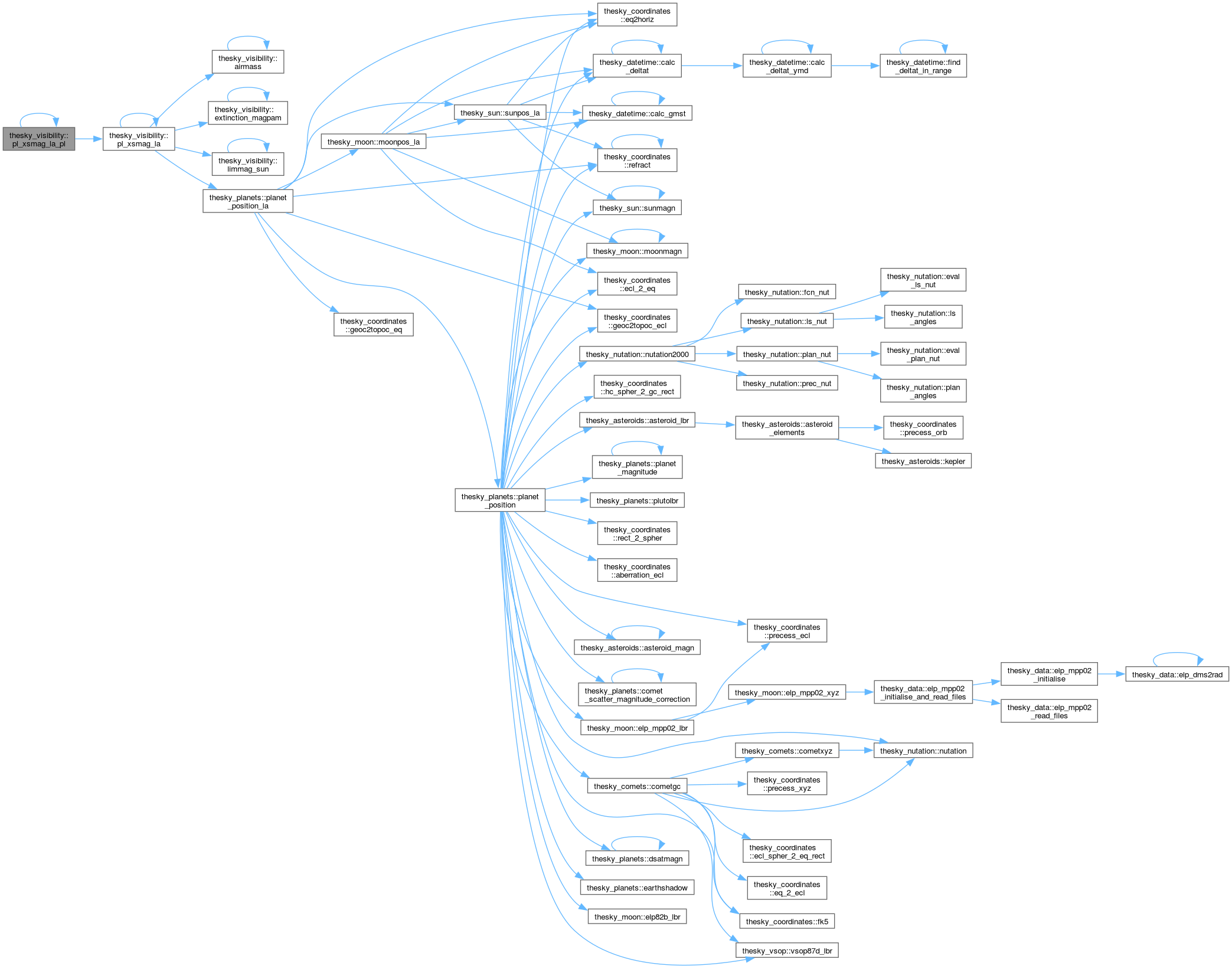
| real(double) function thesky_visibility::pl_xsmag_pl | ( | real(double), intent(in) | jd | ) |
Compute the excess magnitude at JD, wrapper for pl_xsmag() for solvers. The planet ID pl0 is passed through module planetdata.
| jd | Julian day for moment of interest |
| pl_xsmag_pl | The excess magnitude |
Definition at line 1248 of file visibility.f90.
References thesky_planetdata::pl0, pl_xsmag(), and pl_xsmag_pl().
Referenced by best_planet_xsmag(), and pl_xsmag_pl().
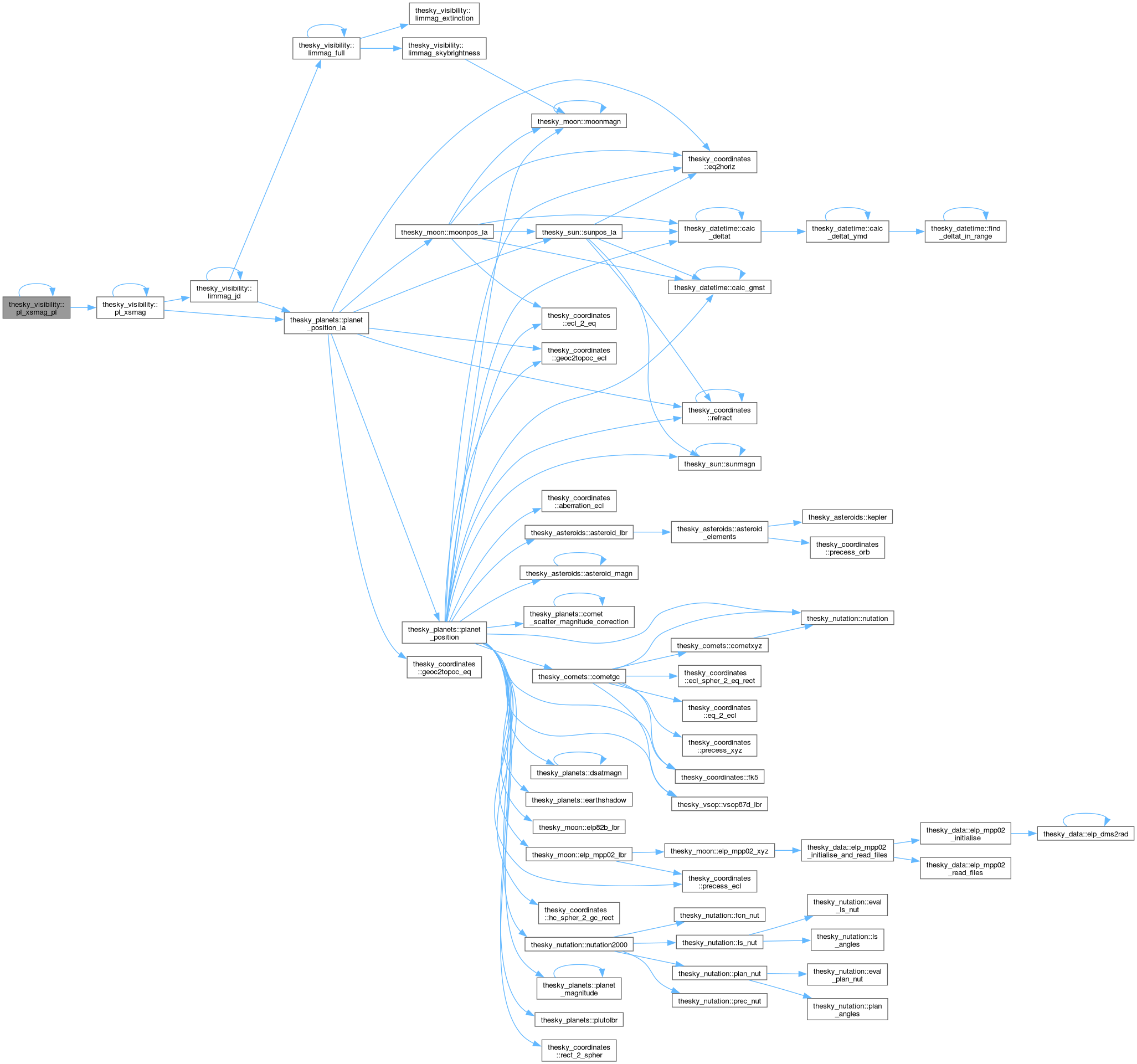
| subroutine thesky_visibility::planet_visibility_tonight | ( | real(double), intent(in) | jd, |
| integer, intent(in) | pl, | ||
| real(double), intent(in) | sunalt, | ||
| real(double), intent(in) | plalt, | ||
| integer, intent(in) | comp, | ||
| real(double), dimension(2), intent(out) | plvis, | ||
| real(double), dimension(2), intent(out), optional | plazs, | ||
| real(double), dimension(5), intent(out), optional | rts, | ||
| real(double), dimension(5), intent(out), optional | tts, | ||
| real(double), dimension(5), intent(out), optional | sts, | ||
| real(double), dimension(5), intent(out), optional | ras, | ||
| real(double), dimension(5), intent(out), optional | tas, | ||
| real(double), dimension(5), intent(out), optional | sas, | ||
| logical, intent(in), optional | rscwarn ) |
Compute when a given planet is visible in a given night.
| jd | Julian day for calculation |
| pl | Planet ID (1-2, 4-8 for Mer-Ven, Mar-Nep) |
| sunAlt | Sun altitude below which planet is visible (deg; e.g. -6.d0) |
| plalt | Planet altitude above which planet is visible (deg; e.g. 5.d0) |
| comp | Compute: 1-compute twilight/planet at plalt events only, 2-include actual rise/set times 11, 12 = 1, 2 + compute only for today, not tomorrow |
| plvis | Planet visibility times (hours): 1-begin, 2-end; plvis(1)*plvis(2) = 0 when invisible (output) |
| plazs | Planet visibility azimuths (rad): 1-begin of visibility, 2-end of visibility (output) |
| rts | "Rise times": 1-twilight (Sun at sunAlt), 2-Sun rise/set, 4-planet at plalt, 5-planet rise/set (output) |
| tts | Transit times: 1-2, of Sun, 4-5 of planet (output) |
| sts | "Set times": 1-twilight (Sun at sunAlt), 2-Sun rise/set, 4-planet at plalt, 5-planet rise/set (output) |
| ras | Rise azimuths: 1-2, of Sun, 4-5 of planet (output) |
| tas | Transit altitudes: 1-2, of Sun, 4-5 of planet (output) |
| sas | Set azimuths: 1-2, of Sun, 4-5 of planet (output) |
| rsCWarn | Print convergence warnings in riset() (optional; default = true) |
Definition at line 215 of file visibility.f90.
References thesky_riset::riset().
Referenced by best_planet_xsmag().
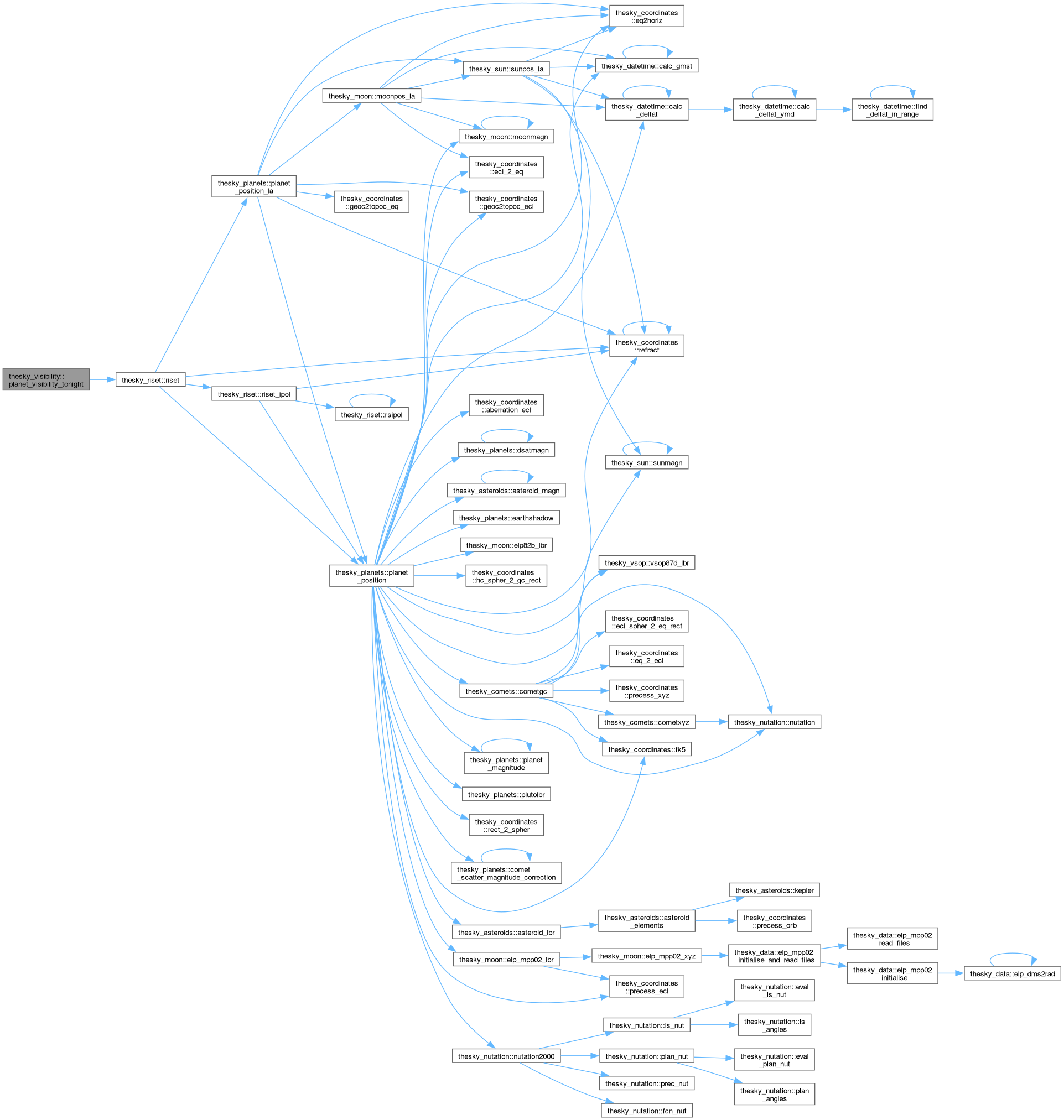
| elemental real(double) function thesky_visibility::skybrightness_cdm2_from_mlim | ( | real(double), intent(in) | mlim | ) |
Convert limiting visual magnitude to sky brightness in candela per square meter.
| mlim | Naked-eye visual limiting magnitude (V) |
| Sky | brightness in cd/m^2 |
Definition at line 1451 of file visibility.f90.
References skybrightness_cdm2_from_mlim(), and skybrightness_cdm2_from_nl().
Referenced by skybrightness_cdm2_from_mlim().

| elemental real(double) function thesky_visibility::skybrightness_cdm2_from_nl | ( | real(double), intent(in) | nl | ) |
Convert sky brightness in nanolambert to candela per square meter.
| nL | Sky brightness in nanolambert (nL) |
| Sky | brightness in candela per square meter (cd/m^2) |
Definition at line 1475 of file visibility.f90.
References skybrightness_cdm2_from_nl().
Referenced by skybrightness_cdm2_from_mlim(), and skybrightness_cdm2_from_nl().

| elemental real(double) function thesky_visibility::skybrightness_mas2_from_mlim | ( | real(double), intent(in) | mlim | ) |
Convert naked-eye visual limiting magnitude (V) to sky surface brightness in (B) magnitudes per square arcsecond.
| Mlim | Naked-eye visual limiting magnitude (V) |
| skybrightness_mas2_from_mlim | Sky surface brightness in (B) magnitudes per square arcsecond |
Definition at line 1377 of file visibility.f90.
References skybrightness_mas2_from_mlim().
Referenced by skybrightness_mas2_from_mlim().

| elemental real(double) function thesky_visibility::skybrightness_mlim_from_cdm2 | ( | real(double), intent(in) | cdm2 | ) |
Convert sky brightness in candela per square meter to naked-eye visual limiting magnitude (V)
| cdm2 | Sky brightness in cd/m^2 |
| Naked-eye | visual limiting magnitude (V) |
Definition at line 1426 of file visibility.f90.
References skybrightness_mlim_from_cdm2(), and skybrightness_nl_from_cdm2().
Referenced by skybrightness_mlim_from_cdm2().

| elemental real(double) function thesky_visibility::skybrightness_mlim_from_mas2 | ( | real(double), intent(in) | skybright | ) |
Convert sky surface brightness in (B) magnitudes per square arcsecond to naked-eye visual limiting magnitude (V)
| skyBright | Sky surface brightness in (B) magnitudes per square arcsecond |
| skybrightness_mlim_from_mas2 | Naked-eye visual limiting magnitude (V) |
Definition at line 1403 of file visibility.f90.
References skybrightness_mlim_from_mas2().
Referenced by skybrightness_mlim_from_mas2().

| elemental real(double) function thesky_visibility::skybrightness_nl_from_cdm2 | ( | real(double), intent(in) | cdm2 | ) |
Convert sky brightness in candela per square meter to nanolambert.
| cdm2 | Sky brightness in candela per square meter (cd/m^2) |
| Sky | brightness in nanolambert (nL) |
Definition at line 1494 of file visibility.f90.
References skybrightness_nl_from_cdm2().
Referenced by skybrightness_mlim_from_cdm2(), and skybrightness_nl_from_cdm2().

| real(double) function thesky_visibility::transitalt | ( | real(double), intent(in) | lat, |
| real(double), intent(in) | dec ) |
Compute the transit altitude of an object with given declination for an observer with a given geographic latitude.
| lat | Geographic latitude of the observer (-pi/2 - pi/2; rad) |
| dec | Declination of the object (-pi/2 - pi/2; rad) |
| transitalt | Transit altitude (rad) |
Definition at line 441 of file visibility.f90.
References transitalt().
Referenced by comet_invisible(), and transitalt().
